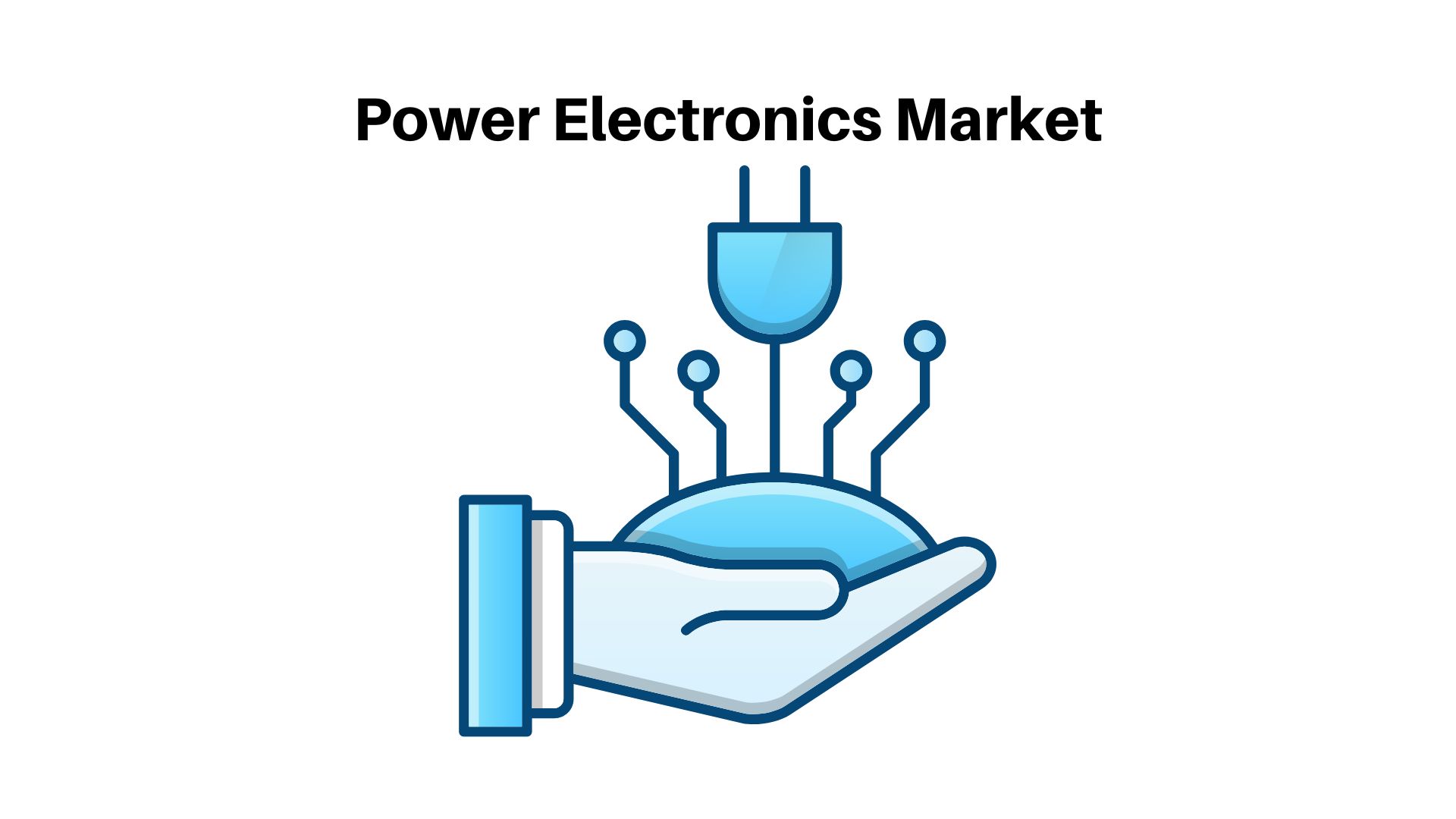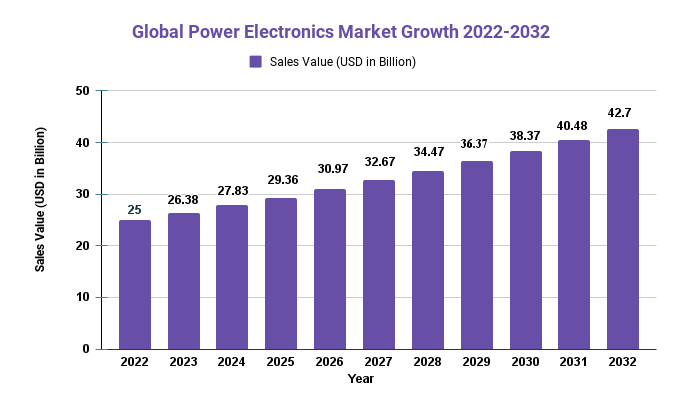Power Electronics Market to Hit USD 42.70 billion by 2032

Page Contents
Published Via 11Press: The Global Power Electronics Market size is expected to be worth around USD 42.70 Billion by 2032 from USD 25 Billion in 2022, growing at a CAGR of 5.50% during the forecast period from 2022 to 2032.
Power electronics is an ever-evolving industry that deals with the conversion, control and management of electrical energy. This technology has applications in renewable energy systems, electric vehicles, industrial automation, consumer electronics products and more. Forecasts suggest the market will experience substantial growth over the coming years due to rising demand for energy-efficient products and increased adoption of renewable sources of power.
Some of the primary drivers for growth in the power electronics market include increasing demand for electric vehicles, increased interest in renewable energy systems and an urgent need for energy-efficient solutions across various industries. Furthermore, advances in technologies and increasing applications of power electronics are further fueling its expansion.
The power electronics market is divided into several segments, such as power modules, integrated circuits (ICs), and discrete components. Power modules are utilized in applications like renewable energy systems, transportation, and industrial automation while power ICs are found in consumer electronics, telecommunications systems, automotive electronics, and power supplies.
Overall, the power electronics market is an exciting and rapidly developing sector that is playing a vital role in providing energy-saving and sustainable solutions to meet growing demands.
Request For Sample Report Here: https://the-market.us/report/power-electronics-market/request-sample/
Power generation companies around the world are taking unprecedented actions to incorporate renewable technologies and meet zero-emission targets. This presents exciting business opportunities for power electronics manufacturers. Furthermore, these leaders are leading the charge on innovation and improvements designed to boost efficiency levels.
With the rapid adoption of photovoltaic (PV), grid-tied renewable energy systems, there is an increasing need for power models that support high-efficiency power converters. These modules reduce costs per watt while maximizing solar cell extraction – thus our dependence on them. Furthermore, they detect faults quickly and help manage inverters and converters efficiently.

Key Takeaways
- The power electronics market grew to USD 25 Billion in 2022.
- Forecasted compound annual growth rates between 2022 and 2032 is 5.50%.
- By 2032, the power electronics market is projected to reach USD 42.70 Billion.
- Power electronics is an ever-expanding industry that involves the conversion, control, and management of electrical energy.
- Power electronics market growth is being spurred on by an increase in electric vehicle ownership, the growing acceptance of renewable energy systems, and the need for energy-saving solutions across various industries.
- The power electronics market is further segmented into power modules, power integrated circuits (ICs), discrete power products, and others.
- Power electronics market growth is expected to be led by Asia-Pacific countries such as China, Japan, and India, due to increasing demand for energy-saving products.
- Other major regions for the market include North America and Europe, which are expected to experience strong expansion over the coming years.
- Overall, the power electronics market is an energetic and rapidly developing sector that plays a crucial role in meeting rising demands for energy-saving and sustainable solutions.
Regional Analysis
- The Asia Pacific semiconductor market is primarily driven by Taiwanese, Chinese, Japan, South Korea and South Korea. Together they account for around ~64% of global discrete semiconductor sales; however, other countries such as Vietnam, Thailand and Singapore also play a significant role in this region's dominance.
- China and Asia have witnessed an explosive growth of the automotive industry. China's government recognizes it as one of its key industries, with output expected to surpass ~36 million units by 2025 which fueling demand in this space.
- Data centers are also on the rise in this region, and regional governments play a major role in market developments. According to MEITY, India is working on policies that will create an industrial base for power and semiconductor components within their borders.
- The region's economy is flourishing thanks to the technology boom. Innovative devices like internet connected smart watches and connected appliances are creating new demand for components like power semiconductors. South Korea, India and Singapore will benefit most from this trend.
- Power electronics vendors in Asia play an essential role in consumer electronics, electric vehicle manufacturing and energy/power/water sectors. As Asia is both the largest consumer and producer of electronic gadgets, there will likely be further opportunities created.
- China's rapidly developing electronics sector may account for the surge of its studied market. Electronics, which is its leading industry, also plays an integral role in driving its overall economic expansion.
- According to the State Council of the People's Republic of China, added value at major electronics manufacturers increased ~12.7% annually compared to ~7.5% growth in China's overall industrial sector. China is currently the world's top producer of electronic devices such as TVs, smartphones and laptops, in addition to PCs and computers.
Drivers
The power electronics market is driven by energy-saving solutions One major driver of the power electronics market is an increasing need for energy-saving solutions across various industries. Power electronics technology helps convert, control, and manage electrical energy more effectively essential for cutting down on energy usage and costs. The power electronics market is driven by the increasing adoption of renewable energy sources Solar and wind power are leading the charge in renewable energy usage, necessitating power electronics technology to convert and manage it efficiently thus becoming a key enabler in this space.
Rising Demand for Electric Vehicles The growing popularity of electric vehicles is another important driver of the power electronics market. Power electronics technology is extensively employed in electric vehicles for motor control, battery management, and charging systems. Advancements in Technology Innovations in power electronics technology are driving the market, as new and more efficient components are being created. This includes improvements to power semiconductor materials, packaging technologies, and control algorithms.
Power Electronics Driven by Automation in Industries The trend towards automation in industries is fueling the demand for power electronics. This technology is widely employed in industrial automation systems for motor control, power conversion, and energy management.
Overall, the power electronics market is being driven by several factors such as a need for energy-saving solutions, increasing adoption of renewable sources and electric vehicles, advances in technology, and an overall trend toward automation across industries.
Restraints
High initial investment costs One of the primary challenges faced by the power electronics market is its high initial investment costs. Power electronics require specialized components and materials which may be expensive to produce or purchase, making it difficult for small and medium-sized enterprises to break into this niche market.
The complexity of Power Electronics Systems Another challenge facing the power electronics market is its complexity. Power electronics technology requires specialized knowledge to design and manufacture, making it difficult for companies to acquire enough skilled personnel with the necessary knowledge. Lack of Standardization Lack of standardization in power electronics poses another obstacle for the market. Different manufacturers use different specifications and standards, making it difficult for end-users to integrate components from various suppliers. This also poses issues when trying to achieve interoperability or create efficient supply chains.
Technological Limitations Technological limitations can be a barrier to the power electronics market. Some applications, such as high-voltage direct current (HVDC) transmission, necessitate specialized components which may not yet be widely accessible or cost-effective. Furthermore, power electronics systems may not always meet the stringent efficiency and reliability criteria required in certain scenarios. Competition from other technologies For the power electronics market, competition from alternative technologies such as mechanical or hydraulic systems may pose a challenge. In some instances, these alternative options may be more cost-effective or provide superior performance.
Overall, the power electronics market is faced with some significant obstacles such as high initial investment costs, the complexity of systems, lack of standardization, technological limitations, and competition from other technologies. Nonetheless, these obstacles can be overcome through continued investment in research and development activities, standardization efforts, and collaboration between industry stakeholders.
Opportunities
The growth of renewable energy presents an exciting opportunity for power electronics manufacturers. As more renewable sources are integrated into the grid, power electronics technology will become essential to enable efficient power conversion and management. The rising demand for electric vehicles provides a significant opportunity to the power electronics market.
Power electronics technology is essential for the efficient running of electric vehicles, and as the demand for these vehicles grows, so will the need for power electronics components. Industrial automation offers a unique opportunity for power electronics vendors, as more industrial processes become automated. Power electronics technology is heavily utilized in these systems, and as automation spreads, so will the need for power electronics components.
Smart Grid Development The development of smart grids presents an opportunity for the power electronics market, as power electronics technology will be essential for efficient and dependable operation in these systems. Power electronics components are used in smart meters, power inverters, and other elements within a smart grid system. Advancements in Technology
Advancements in power electronics technology present another growth avenue as new and more efficient components are created – this includes improvements to semiconductor materials, packaging technologies, and control algorithms.
Overall, the power electronics market presents significant growth prospects due to the expansion of renewable energy sources, an increasing demand for electric vehicles, industrial automation, smart grid development, and technological advances. If these trends continue, the power electronics market is expected to expand and develop to meet these emerging needs.
Challenges
The power electronics market confronts increasing competition One of the primary difficulties faced by this sector is an expanding pool of competitors. As more firms join the sector, price pressure will likely increase and profit margins may be compromised. Technological advancements provide power electronics companies with opportunities, but they also pose challenges. To stay competitive and stay abreast of technological progress, power electronics companies must invest in research and development to stay abreast.
Supply chain disruptions Disruptions in the supply chain can present a challenge for power electronics businesses. For instance, during the COVID-19 pandemic, there were widespread disruptions, leading to shortages of raw materials and components. Intellectual Property Disputes can be a burden for the power electronics market. As companies develop new technologies and products, disputes over patents and intellectual property rights may arise – leading to legal troubles and increased costs. Environmental Concerns Environmental issues, such as the use of hazardous materials in power electronics components, can pose a challenge to the market. With consumers becoming more eco-conscious, pressure is mounting on power electronics companies to develop eco-friendly products and processes.
Overall, the power electronics market faces numerous challenges such as increasing competition, technological advances, supply chain disruptions, intellectual property disputes, and environmental concerns. To combat these obstacles companies must be innovative, agile, and adaptable they also need to invest in research and development, supply chain management services, and environmental sustainability initiatives.
Recent Development
- April 2022: DENSO Corporation, a supplier of mobility, and United Semiconductor Japan Co., Ltd., a subsidiary of global semiconductor findry United Microelectronics Corporation, announced their collaboration on power semiconductor production at USJC's 300mm fab in order to meet growing automotive demand.
- March 2022: Reliance Industries formed a partnership to produce electronics in India with Sanmina Corp (a US-based company). Reliance Strategic Business Ventures Limited, a wholly owned subsidiary of the oil to-telecom conglomerate will form a joint venture by investing in Sanmina SCI India Pvt. Ltd.
Key Market Segments
Type
- Power Discrete
- Power Modules
- Power ICs
Application
- ICT
- Consumer Electronics
- Energy & Power
- Industrial
- Automotive
- Aerospace & Defense
- Others
Key Market Players
- Infineon
- Texas Instruments
- On Semiconductor
- STMicroelectronics
- Mitsubishi Electric
- Fuji Electric
- Renesas Electronics
- Toshiba
- NXP Semiconductors
- Vishay Intertechnology
- Maxim Integrated Products
- Semikron
- ABB
- Hitachi
- Analog Devices
- ROHM Semiconductor
- Microsemi Corporation
- Littelfuse
- Microchip Technology
- Danfoss
Report Scope
| Report Attribute | Details |
| The market size value in 2022 | USD 25 Bn |
| Revenue forecast by 2032 | USD 42.70 Bn |
| Growth Rate | CAGR Of 5.50% |
| Regions Covered | North America, Europe, Asia Pacific, Latin America, and Middle East & Africa, and the Rest of the World |
| Historical Years | 2017-2022 |
| Base Year | 2022 |
| Estimated Year | 2023 |
| Short-Term Projection Year | 2028 |
| Long-Term Projected Year | 2032 |
Contact us
Contact Person: Mr. Lawrence John
Market.us (Powered By Prudour Pvt. Ltd.)
Tel: +1 718 618 4351
Send Email: [email protected]
FAQ.
The Power electronics market is studied from 2017 - 2032.
The Power electronics market is growing at a CAGR of 5.50%
Asia Pacific is growing at the highest CAGR over 2022- 2032.
North America holds the highest share in 2022.
Infineon, Texas Instruments, On Semiconductor, STMicroelectronics, Mitsubishi Electric, Fuji Electric, Renesas Electronics, Toshiba, NXP Semiconductors, Vishay Intertechnology, Maxim Integrated Products, Semikron, ABB, Hitachi, Analog Devices, ROHM Semiconductor, Microsemi Corporation, Littelfuse, Microchip Technology and Danfoss.
The team behind market.us, marketresearch.biz, market.biz and more. Our purpose is to keep our customers ahead of the game with regard to the markets. They may fluctuate up or down, but we will help you to stay ahead of the curve in these market fluctuations. Our consistent growth and ability to deliver in-depth analyses and market insight has engaged genuine market players. They have faith in us to offer the data and information they require to make balanced and decisive marketing decisions.



